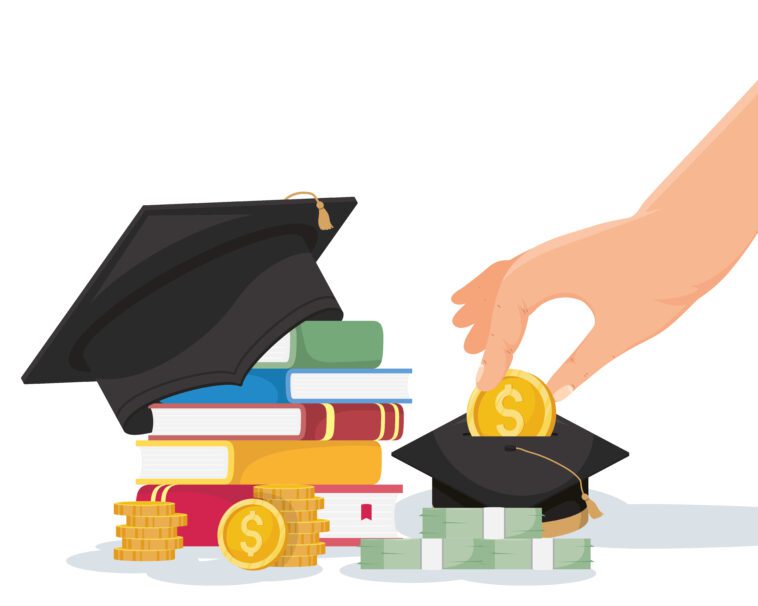Student loans can help bridge any gaps left by scholarships, grants and other forms of financial aid; however, interest rates play an impactful part in your monthly repayment costs.
Private student loan lenders assess your creditworthiness and may request that a cosigner sign on. Some lenders offer fast cosigner release policies; often after 12 consecutive on-time payments have been made without issue.
Costs
While student debt may offer numerous advantages, it’s essential that borrowers fully comprehend its associated costs. This includes loan origination fees, interest rate adjustments and repayment schedules as well as late fee charges and penalties incurred from late payments or penalties imposed for late payments after graduation. Overall, these costs can add up and make a considerable impactful difference on how much borrowers must repay after graduating; fortunately there are ways to minimize them; among them being forgoing credit cards altogether for college expenses in favor of flexible payment plans that allow borrowers choose how much each month is repaid back each month based on your budgeting options.
As college education costs have skyrocketed in recent years, more and more students have taken out student loans to pay their tuition bills. Unfortunately, this debt burden is becoming an increasing strain for middle-class Americans and makes building wealth difficult; to help alleviate it further the government has instituted various student loan relief programs that offer relief to borrowers.
However, these programs are expensive for the federal government. According to estimates by the Department of Education’s budget office, its Direct Loan program will cost an estimated $197 billion by 2021 (up from an estimated cost of $114 billion in 2016). Their model uses variables like wage growth projections and interest rate assumptions in order to produce official cost estimates of this loan program.
To properly assess costs, the government includes administrative fees it pays when administering loans – these costs range between 4.45-7% for federal student loans and 11-15% from private student loan providers; they’re an often forgotten factor when considering borrowing for college.
Borrowers also incur administrative and interest costs on their loan, contributing to an increasingly higher monthly student loan payment. Therefore, it is crucial that prospective college students explore all available financing options, whether student loans or scholarships; before making their decision.
Eligibility
Student loans can be an essential financial resource for college students, but they come with certain strict eligibility requirements. Borrower approval depends on their credit history, school choice and ability to repay the loan on time; missed payments could adversely impact both these aspects and future loan approval chances – it is vital that all alternative financing solutions have been exhausted first before considering student loans as the solution.
The eligibility requirements for student loans depend on both lender and program; some federal programs require students to demonstrate financial need while other loans such as Direct Subsidized and Unsubsidized Loan programs have annual and aggregate borrowing limits with a six-month grace period before repayment begins. Private student loans also have different criteria including credit and income requirements.
As a general guideline, applicants for student loans must be United States citizens or eligible noncitizens who possess either a high school diploma or the equivalent and be enrolled in an eligible degree or certificate program. New freshman do not need to meet GPA or income criteria in order to demonstrate acceptance into enrollment and being able to afford costs of attendance; graduate and professional students may have specific GPA or income criteria depending on their school; additionally borrowers must maintain satisfactory academic progress and fulfill other requirements in order to continue receiving assistance.
Private student loan eligibility can be more stringent than applying for federal student loans, typically including credit checks and cosigner approval processes. Individuals without an established credit history often find that their applications are denied, however these individuals may still meet other requirements by finding someone willing to guarantee repayment in case of default, along with meeting other necessary criteria.
Sallie Mae is one of the premier student loan providers, offering flexible repayment plans and member benefits. To qualify for a Sallie Mae loan, applicants must either have excellent credit scores or be cosigned by someone qualified; international and DACA students can also use cosigners from U.S. citizenship or permanent resident households as creditworthy cosigners to apply.
Interest rates
Student loans can help bridge any financial gaps when scholarships, grants and other forms of aid don’t cover all your education expenses. But keep in mind that borrowing money doesn’t come for free: interest rates determine both how much you owe and your monthly payment amount – make sure you do your research to find the best possible deal before signing any contracts!
Federal loan interest rates tend to be significantly lower than private lender interest rates, though they can fluctuate year by year. Since 2013, rates have been tied to the 10-year Treasury note auction rate with undergraduate and graduate loans subject to an added margin. Rates for Direct Subsidized and Unsubsidized Loans are set annually.
As your loan balance decreases, so too will your monthly payments decrease as well. A payment calculator can help you estimate the approximate costs associated with each of your loans throughout their repayment terms.
While federal student loan interest rates are currently relatively low, they’re projected to increase this summer and existing students who take out new loans for the coming academic year may see their interest rates significantly rise. Furthermore, pandemic-related benefits that temporarily halted payments and interest are set to end later this year.
Private lender interest rates tend to be higher than federal student loan interest rates, yet still remain highly competitive when compared with other forms of borrowing such as credit cards. Furthermore, private lenders provide various repayment options including plans that enable you to customize the monthly amount you owe them.
Some private lenders provide incentives to entice applicants to apply for loans with them, including reduced interest rates if you sign up for automatic payment deductions and/or apply for multiple student loans with them; the weighted average of your consolidated rates will likely be less than any single loan’s individual rates.
Repayment
Assuming student loans is a significant commitment, so it is vital that you understand your repayment options thoroughly before signing on the dotted line. There are various strategies available to you for reducing loan costs such as deferred repayment, reduced payment plans and income-driven plans; depending on your unique circumstances you might also want to look into refinancing them.
Income-driven repayment plans, which set monthly payments based on family size and income, have become increasingly popular with borrowers. Available both federally and privately funded loans, income-driven repayment plans may help save you money by lowering monthly payments; however, these may not be suitable for everyone – it is therefore wise to research all options thoroughly prior to choosing one.
Extended repayment, graduated repayment and revised pay-as-you-earn repayment are three other repayment plans available to federal loan borrowers in addition to standard repayment: extended repayment, graduated repayment and revised pay-as-you-earn repayment. Each of these can help lower monthly payments by stretching out loan terms up to 30 years; however, longer loan terms will increase overall interest payments over the life of your loan.
Consolidate your federal student loans into one, more manageable payment. While doing this may lower monthly payments, over time you could end up paying more because of an extended repayment period. Furthermore, refinancing could offer lower interest rates.
Repayment options for private student loans can differ considerably between lenders. Some may offer fixed monthly payments over their entire term while others require variable payments dependent upon your income and expenses. Some also allow deferment during school years or during a separation or grace period.
Repaying student loans typically involves standard and graduated repayment plans; with graduated plans providing lower initial payments that increase gradually over time. Additionally, the government offers several alternative repayment plans such as income-based and pay-as-you-earn plans; however these tend to be more expensive than standard plans.



